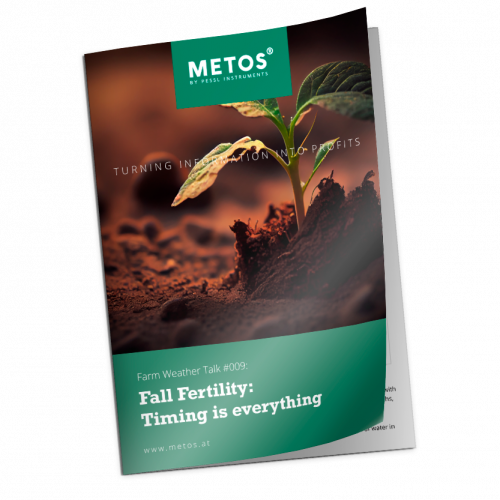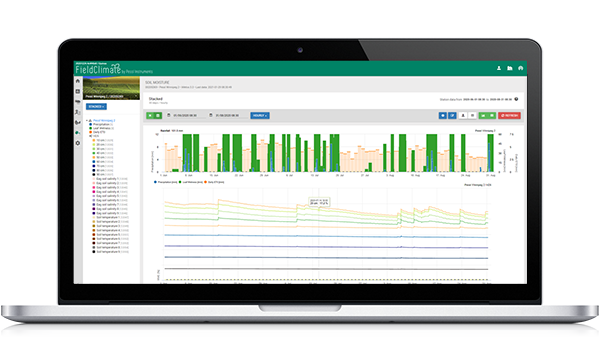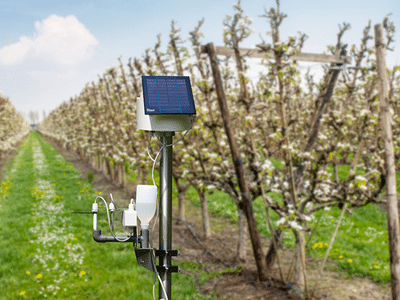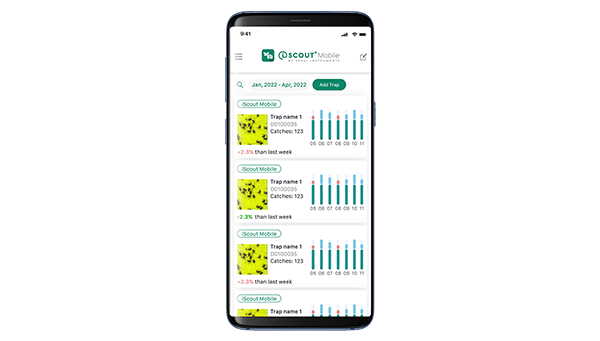Mother nature plays an important role in when fall fertilizers should be applied. Read a new blog in the Farm Weather Talk series by Guy Ash, METOS® Global Training Manager.
Fall Fertility – Timing is Everything
As the expression states, “Timing is Everything”, which is such the case for fall application of fertilizers. As expected, mother nature (weather) again plays an important role in when fall fertilizers should be applied. As part of the 4r nutrient management, timing of when to apply nutrients is critical through the growing season to avoid losses to leaching, denitrification, immobilization, volatilization and especially today with the emphasis on reducing Nitrous oxide (N2O) release from soil because of its increasing importance in climate change/variability.
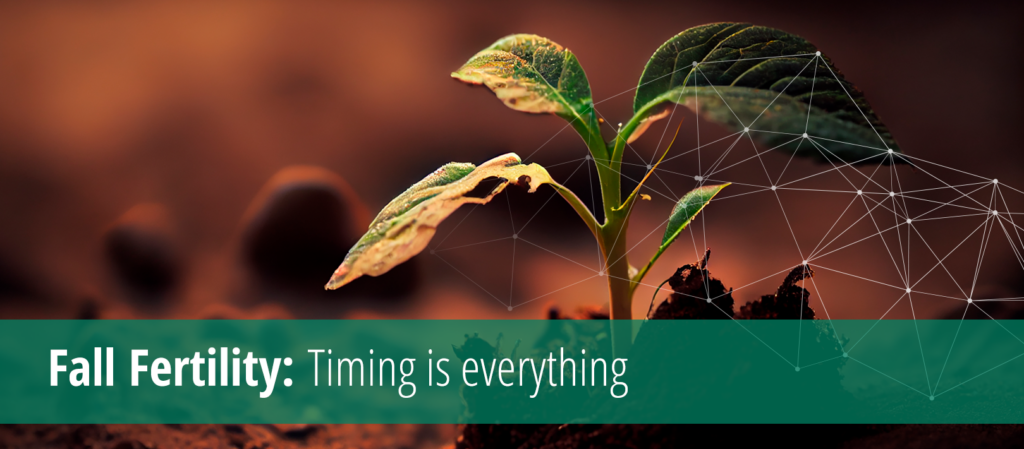

Knowing field specific soil temperatures and moisture conditions is becoming increasingly important today with the cost of fertilizers, optimizing yields/quality, and reducing losses from leaching and denitrification (nitrous oxides & dinitrogen gasses) impacting climate change/ variability. Changing fall weather patterns are making it necessary to monitor in-field soil temperatures/moisture to ensure the correct application dates. With today’s field-level IoT devices, it’s quite easy to have a real-time picture of the soil temperature/moisture conditions for any field or cropzone. One can install an IoT device with a soil probe that measures soil temperature/moisture/VIC (volumetric ion content) every 10 cm, with the first measurement at 5 cm.
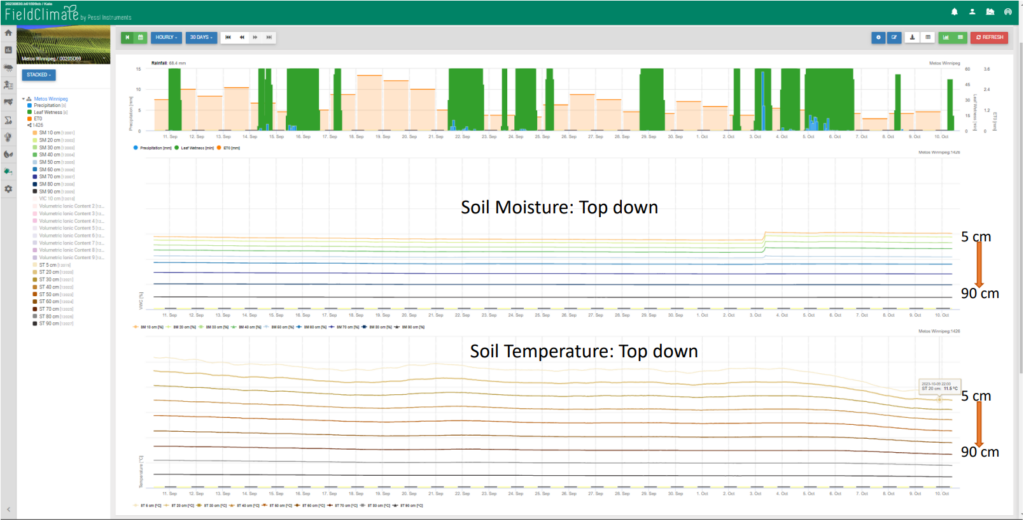

Background Information on the Importance of Soil Temperature and Moisture for fall fertility application
Many studies have identified that soil temperature and moisture can have a significant effect on the effectiveness of fall fertility applications. For example, knowing in-field soil temperatures over a period in the fall is an important factor to track for timing of application. Applying anhydrous ammonia at the right soil temperature will slow the conversion and reduce losses, due to denitrification. The table below illustrates nitrification rates (number of days) of ammonia to nitrate form-N, based on soil temperatures at banding depth. Fertility application to cool soils means the bacteria perform slower at converting and reduce nitrification losses.


Slowing down the denitrification and nitrification processes is important so that the fertility stays in the usable form and doesn’t convert to nitrous oxide (N2O), which is a potent greenhouse gas for climate change/variability. So, the factors for affecting denitrification and nitrification include soil temperature/moisture conditions, aeration, organic matter, and microbial activity, and we can effectively manage these processes (denitrification & nitrification) by applying at the right time, i.e., low soil temperature and soil moisture.
In the ideal world, fall fertility applications should begin when the 5-10 cm soil temperatures reach about 5°C, and soil moisture is below field capacity (not saturated) but this doesn’t take into account fall weather conditions that may be uncooperative before fall freeze up, so there are other tools in the tool box such as enhance fertilizer efficiency products (urease inhibitors, nitrification inhibitors and polymer coatings), split application of N, variable rate fertilization tools or apply N during rapid crop growth.
From the IoT device perspective a well placed soil probe (soil temperature/moisture/VIC) in a field can provide the tools to alert a customer on when the environment conditions are or are not conducive for fall fertility applications. The image below illustrates the field-level soil moisture and temperature data collected every hour for the top 2 sensors (5 and 15 cm depth) which makes it difficult to see the daily or weekly trends, values range from 4°C to 12°C.
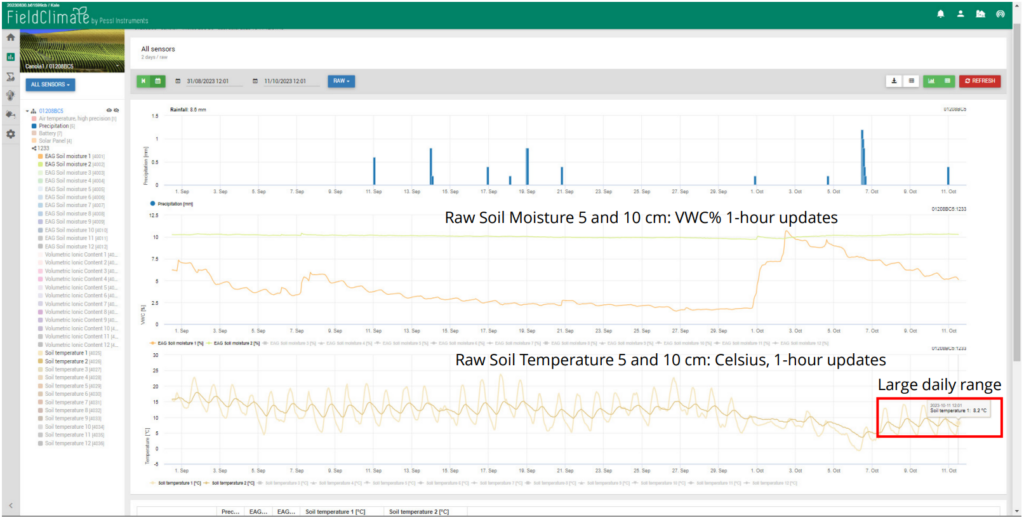

The next image provides a daily average of soil moisture and temperature, with soil temperature values ranging from 2°C to 8°C, which is more useful for determining application timing. We can also see that the soil moisture sensors for the same depth are well below saturation and hence the “timing” for an application based on soil temperature and moisture is in a generally good window (in the 5°C to 8°C range and soil moisture well below saturation).
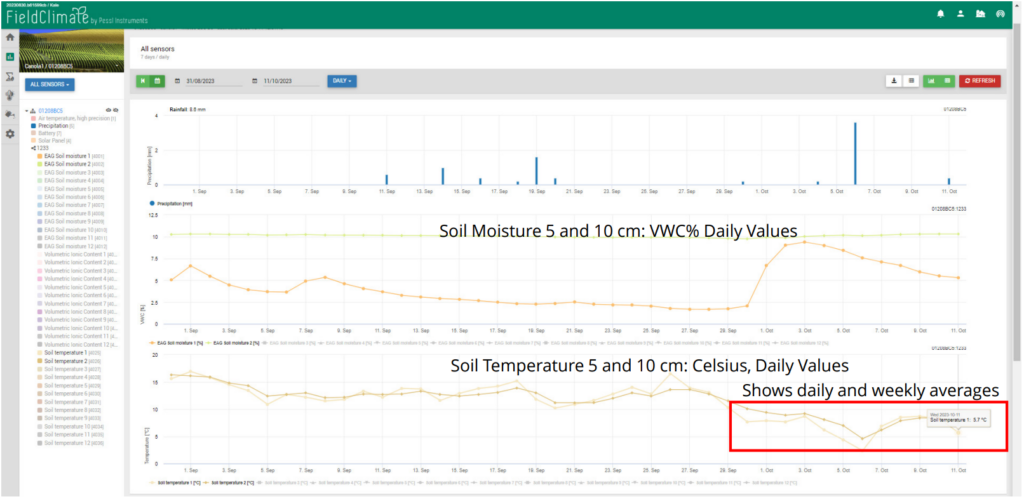

This image shows how to set up an alert for fall fertility applications using the appropriate soil temperature and moisture values, which are then sent to the desktop and mobile app. Here, a soil temperature below 7°C for the 5 cm sensor is set, with the soil moisture below 20% (below saturation). The following illustration shows the notification on the app with the appropriate action.
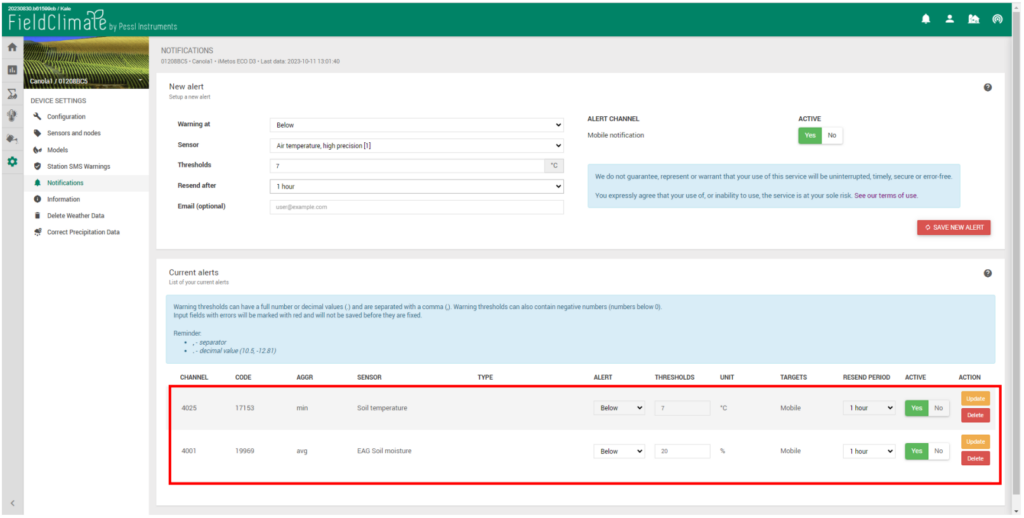

Web Alerts on Your Mobile Phone = Appropriate Work Actions
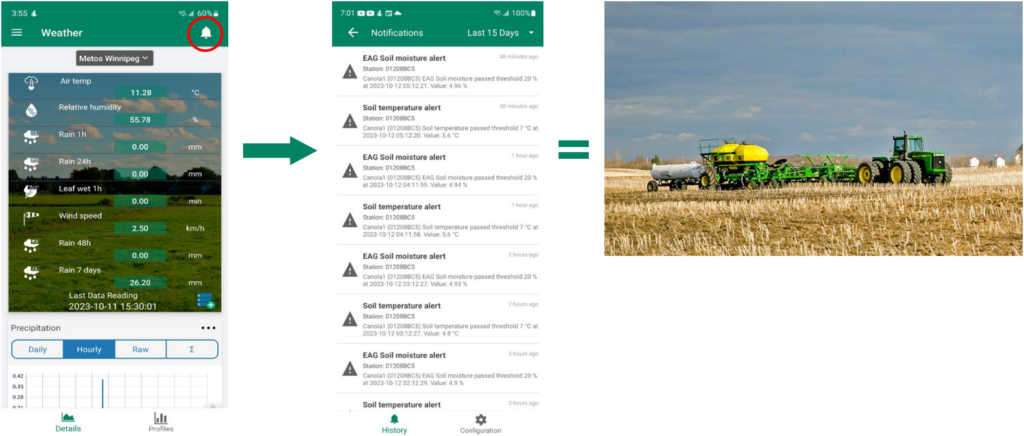

You can also use the field specific forecasts that are built for your IoT device to monitor future temperatures, which help with planning of field operations. The image below illustrates the field-level, hour-by-hour forecast for temperatures, precipitation probability and amounts for the next seven days.


This can be extended out to 14-days using the medium range forecast that is also available for each in-field device with a forecast. This provides the maximum and minimum daily temperature ranges along with the amount and probability of precipitation.
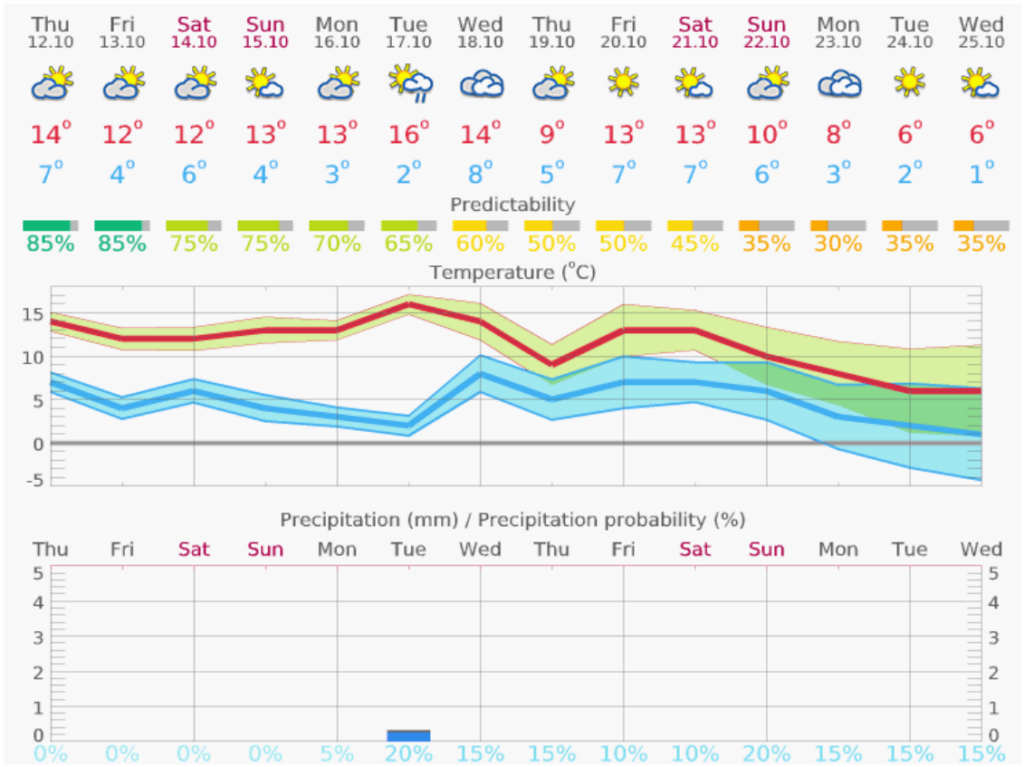

What do all these tools mean?
They allow a grower or agronomist to have more precise information on the current and future conditions for fall fertility applications at the actual field.
This allows the user to plan field-by-field when applications are well “timed”, which has the potential to keep fertilizers in a usable form and reduce the impact of denitrification/nitrification on the conversion to nitrous oxide, a potent greenhouse gas.
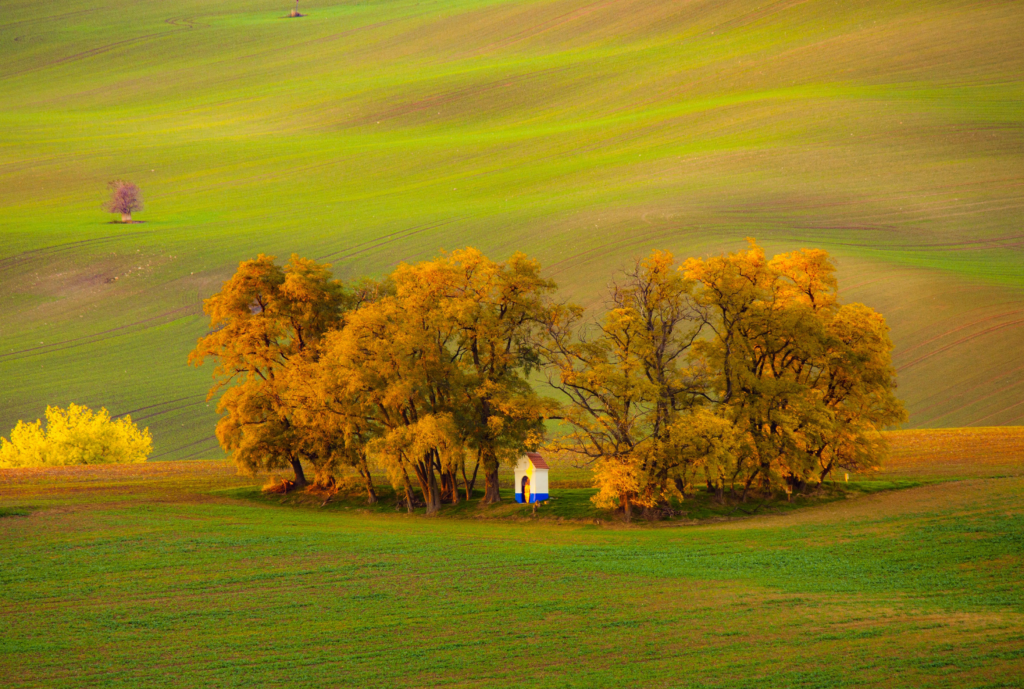

If you are losing 3-5 lbs/ac/day of nitrate-N due to denitrification from warm soil temperatures and wet soils, this adds up in cost from both an economic and environmental perspective. Estimating N losses and adding more nitrogen is a complex process and must be looked at on a field-by-field basis.
Summary and Value Proposition
Like any other science and technology, there are many improved options for having better information and tools for fall fertility decisions. As we know, timely applications of fall fertilizers save money, maximize yield potential, and reduce greenhouse gas emissions.
- Know before you go – save time and money.
- Verify field weather conditions.
- Verify site specific soil temperature and moisture conditions for fall fertility.
- Site specific, field level forecasts.
Want to learn more?
Download the Fall Fertility – Timing is Everything brochure.
